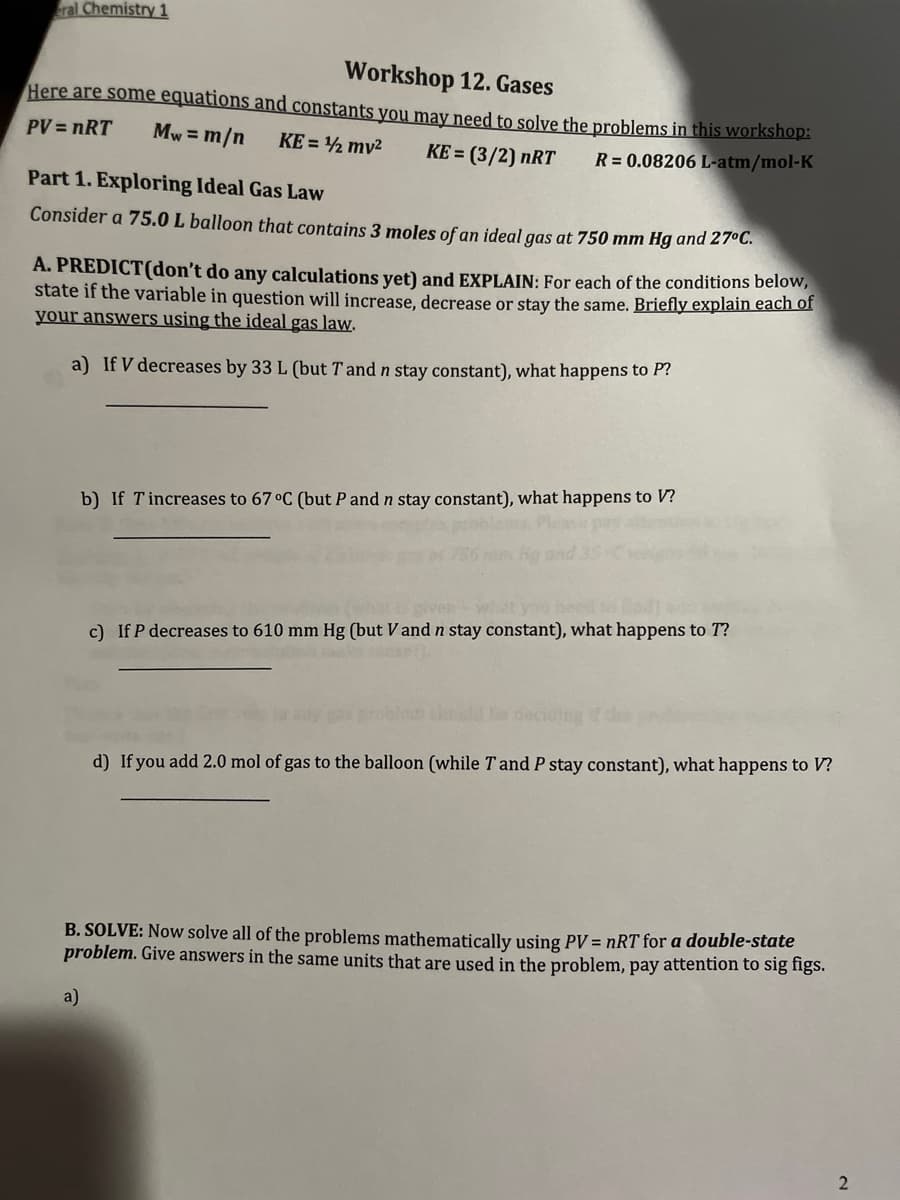eral Chemistry 1 Workshop 12. Gases Here are some equations and constants you may need to solve the problems in this workshop: PV = nRT Mw=m/n KE = 12 mv² KE = (3/2) nRT R = 0.08206 L-atm/mol-K Part 1. Exploring Ideal Gas Law Consider a 75.0 L balloon that contains 3 moles of an ideal gas at 750 mm Hg and 27°C. A. PREDICT (don't do any calculations yet) and EXPLAIN: For each of the conditions below, state if the variable in question will increase, decrease or stay the same. Briefly explain each of your answers using the ideal gas law. a) If V decreases by 33 L (but T and n stay constant), what happens to P? b) If Tincreases to 67 °C (but P and n stay constant), what happens to V? c) If P decreases to 610 mm Hg (but V and n stay constant), what happens to T? d) If you add 2.0 mol of gas to the balloon (while T and P stay constant), what happens to V?
eral Chemistry 1 Workshop 12. Gases Here are some equations and constants you may need to solve the problems in this workshop: PV = nRT Mw=m/n KE = 12 mv² KE = (3/2) nRT R = 0.08206 L-atm/mol-K Part 1. Exploring Ideal Gas Law Consider a 75.0 L balloon that contains 3 moles of an ideal gas at 750 mm Hg and 27°C. A. PREDICT (don't do any calculations yet) and EXPLAIN: For each of the conditions below, state if the variable in question will increase, decrease or stay the same. Briefly explain each of your answers using the ideal gas law. a) If V decreases by 33 L (but T and n stay constant), what happens to P? b) If Tincreases to 67 °C (but P and n stay constant), what happens to V? c) If P decreases to 610 mm Hg (but V and n stay constant), what happens to T? d) If you add 2.0 mol of gas to the balloon (while T and P stay constant), what happens to V?
Chemistry for Engineering Students
4th Edition
ISBN:9781337398909
Author:Lawrence S. Brown, Tom Holme
Publisher:Lawrence S. Brown, Tom Holme
Chapter5: Gases
Section: Chapter Questions
Problem 5.97PAE: 97 Homes in rural areas where natural gas service is not available often rely on propane to fuel...
Related questions
Question
How can we predict a-d with the moles?

Transcribed Image Text:eral Chemistry 1
Workshop 12. Gases
Here are some equations and constants you may need to solve the problems in this workshop:
PV = nRT Mw = m/n KE = ¹2 mv² KE = (3/2) nRT
R = 0.08206 L-atm/mol-K
Part 1. Exploring Ideal Gas Law
Consider a 75.0 L balloon that contains 3 moles of an ideal gas at 750 mm Hg and 27°C.
A. PREDICT(don't do any calculations yet) and EXPLAIN: For each of the conditions below,
state if the variable in question will increase, decrease or stay the same. Briefly explain each of
your answers using the ideal gas law.
a) If V decreases by 33 L (but T and n stay constant), what happens to P?
b) If Tincreases to 67 °C (but P and n stay constant), what happens to V?
a)
c) If P decreases to 610 mm Hg (but V and n stay constant), what happens to T?
d) If you add 2.0 mol of gas to the balloon (while T and P stay constant), what happens to V?
B. SOLVE: Now solve all of the problems mathematically using PV = nRT for a double-state
problem. Give answers in the same units that are used in the problem, pay attention to sig figs.
2
Expert Solution
This question has been solved!
Explore an expertly crafted, step-by-step solution for a thorough understanding of key concepts.
This is a popular solution!
Trending now
This is a popular solution!
Step by step
Solved in 2 steps with 1 images

Knowledge Booster
Learn more about
Need a deep-dive on the concept behind this application? Look no further. Learn more about this topic, chemistry and related others by exploring similar questions and additional content below.Recommended textbooks for you

Chemistry for Engineering Students
Chemistry
ISBN:
9781337398909
Author:
Lawrence S. Brown, Tom Holme
Publisher:
Cengage Learning

Introduction to General, Organic and Biochemistry
Chemistry
ISBN:
9781285869759
Author:
Frederick A. Bettelheim, William H. Brown, Mary K. Campbell, Shawn O. Farrell, Omar Torres
Publisher:
Cengage Learning

Chemistry
Chemistry
ISBN:
9781305957404
Author:
Steven S. Zumdahl, Susan A. Zumdahl, Donald J. DeCoste
Publisher:
Cengage Learning

Chemistry for Engineering Students
Chemistry
ISBN:
9781337398909
Author:
Lawrence S. Brown, Tom Holme
Publisher:
Cengage Learning

Introduction to General, Organic and Biochemistry
Chemistry
ISBN:
9781285869759
Author:
Frederick A. Bettelheim, William H. Brown, Mary K. Campbell, Shawn O. Farrell, Omar Torres
Publisher:
Cengage Learning

Chemistry
Chemistry
ISBN:
9781305957404
Author:
Steven S. Zumdahl, Susan A. Zumdahl, Donald J. DeCoste
Publisher:
Cengage Learning

Chemistry: An Atoms First Approach
Chemistry
ISBN:
9781305079243
Author:
Steven S. Zumdahl, Susan A. Zumdahl
Publisher:
Cengage Learning


Chemistry: The Molecular Science
Chemistry
ISBN:
9781285199047
Author:
John W. Moore, Conrad L. Stanitski
Publisher:
Cengage Learning